

Yana Naidenov. Esource - Hal Watts. Dans le jardin, dans le ciel, dans la cave, Paris. Tailormade Vases : NOAM DOVER & MICHAL CEDERBAUM. A collection of sewn vessels from multi-layered fabric.
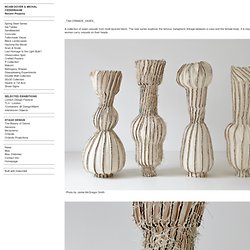
The new series explores the famous metaphoric linkage between a vase and the female body. It is inspired by the way African women carry vessels on their heads. Sandblasted : NOAM DOVER & MICHAL CEDERBAUM. “Sandblasted” begun from collecting second-hand ceramics found in flee markets and private auctions.
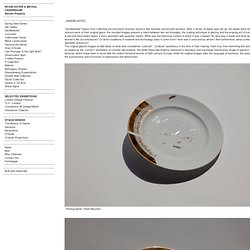
After a series of plates was set up, the plates were selectively sandblasted to remove parts of their original glaze. the resulted images present a clash between two technologies: the coating technique of glazing and the erasing act of sandblasting. A second-hand object bears a story abundant with question marks: What was the historical context in which it was created? By who was it made and what were that craftsman or woman's life circumstances? Amanda Karsberg. Rozmowa Vases, Boxes & Bowls by Amaury Poudray. A series of minimalist works made of copper and glass represent Poland's "citizens in perpetual dialogue with their history and its tenacious roots".
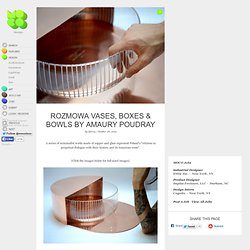
(Click the images below for full sized images) Piotr "Rozmowa is a project that is dear to my heart, directly linked as it is to my experience of Poland. This culture which I got to know well is, fundamentally, very different from my own. It gave me an understanding of the cultural diversity of Europe and the complexity of its history. " says Poudray. Katarzyna. Less: N1 Catenary Pottery Printer by gt2P. More analog: Less: N1 Catenary Pottery Printer by gt2P is an experimental pottery printer that captures the form of suspended fabrics (here, muslin, lycra, gauze).
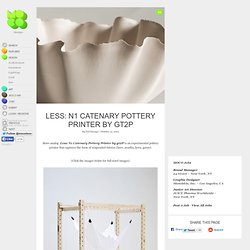
(Click the images below for full sized images) The analog machine incrementally expresses design functions that incorporate physical variables like gravity, fluid weight, and fabric tension, slipcasting volumes and pottery viscosity, in real time - "more parametric, less digital. " The principles and process can be applied to a range of functional objects, from tableware to tables.
Great Things to People - is an architecture, art and design studio in Santiago, Chile. Considered Objects by David Taylor. Peace in making: Created as a way to relax and escape during a period of intense busyness, Considered Objects by David Taylor include a dish, a vase and a mirror, in concrete and brass.
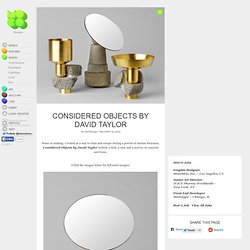
(Click the images below for full sized images) "Some jog, some do yoga, I returned to my workshop for an hour every other day to find peace in making. " Taylor is a Scottish-born, fine arts-educated designer, working in Stockholm, Sweden. Märta Mattsson - Jewellery Artist. Contrast Lighting Collection by Julien Carretero for Victor Hunt. Knitted lamps by Ariel Zuckerman. Category:DesignPublished on 10 Sep, 2013 Tags: Ariel Zuckerman, Lighting Knitted is a series of light fixtures that combines technology with tradition.
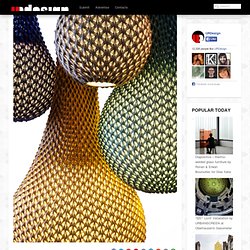
Knitting wool threads in fixed patterns creates a three-dimensional sheet of fabric which serves as a lighting fixture. The project was born from collaboration between Israeli designer Ariel Zuckerman and Oded Sapir. Marine Light made of seaweed by Nir Meiri. Tel Aviv designer Nir Meiri used seaweed to create the shades of these lamps.
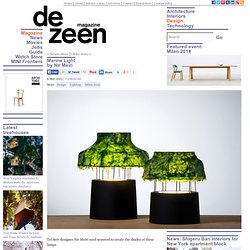
Nir Meiri made the lamps by draping fresh seaweed over a structure of thin metal spokes attached to a metal base. The final shape of each lampshade is formed as the seaweed dries and shrinks, before being set with a preservative. Marine Light was presented at Spazio Rossana Orlandi in Milan last month. Semi-Wrinkle Washi Lamp by Nendo + Taniguchi Aoya Washi. Category:DesignPublished on 05 Dec, 2013 Tags: Lighting, nendo, Taniguchi Aoya Washi Japanese studio Nendo has collaborated with Taniguchi Aoya Washi, renowned for their 3D paper molding technique, to realized a series of ethereal pendant lamps.
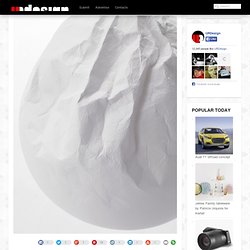
Taniguchi Aoya Washi, a traditional Japanese paper company located in Tottori Prefecture in western Japan, is the country’s only domestic producer of three-dimensional washi. Washi is made by passing fine screens through a bath of plant pulp and water to collect the pulp, then by drying the screens and peeling off the new paper sheets. Rather than pasting sheets of washi together to create forms, the company uses the same process to create beautiful seamless forms that are three-dimensional from the start. However, the results are similar and even enough that the company’s paper forms can be confused with white glass or plastic. All images © HIROSHI IWASAKI. Seasons Vases by Kristine Five Melvær. Category:DesignPublished on 21 Aug, 2013 Tags: Homeware, Kristine Five Melvær Kristine Five Melvær‘s Seasons vases are inspired by the shifting colors of nature through a year.

The first vase is inspired by cherry blossoms and bright green leaves against the clear spring sky. The second vase dives into the summer sea with algae on the bottom and waves on top. The third vase shows golden autumn leaves gradually covering the green ground. The fourth vase interprets winter snow gently falling to the ground. Wooden bike by Mike Kovač. Play Lesenjača as named the Wooden bike is a masterpiece, which was completed in May 2013 by son who had an idea and a father as a joiner, in his own firm 4mk, with a lot of wood experience.
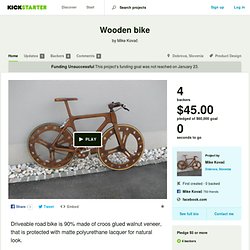
At first it was just an idea with the following question if I can and could. There was a following asignment by a school teacher and Mike started procesing the idea. He started working on a huge project and with a little help of his father and an amazing product was invented. The wooden bike was a big hit everywhere they showed up. At first look we would say that the Wooden bike is only an exhibit, but Mike made it usefull almost on every route. Depending on the reactions, publicity and demanding about the bike from abroad, father and son decided to make it even bigger. STEP ONE: The wooden bike was drawn in Autocad. STEP TWO: 1,5 mm walnut veneer was cross glued together with Tinberbont waterproofed glue.
STEP THREE: With the router were made holes in the frame for the hub, crank and front forks.